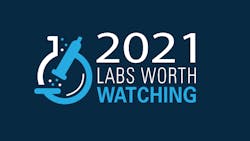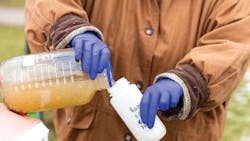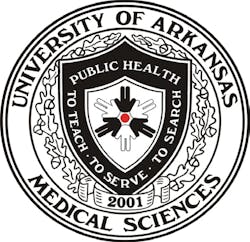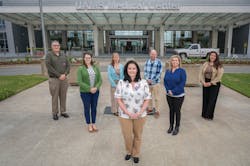The impact of the pandemic resulted in labs devising plans to cope with supply and personnel shortages. Implementing necessary changes in the chaos of the COVID-19 pandemic, a few labs rose above and beyond to conquer unforeseen challenges in creative ways amongst the increased demand, sharing stories that make them Labs Worth Watching.
Medical Laboratory Observer is proud to announce and congratulate the 2021 Lab Innovators Worth Watching (in alphabetical order): Michigan Technological University; UnityPoint Health; University Medical Center of Southern Nevada, PCR Lab; University of Arkansas for Medical Sciences; and the Yale School of Medicine.
UnityPoint Health in Cedar Rapids, IA
“MedLabs patient service centers are small, with limited waiting room space. For leveling out the patient flow and to provide the social distancing recommendations that aligned with COVID respiratory precautions, MedLabs moved away from walk-ins to appointments using Epic in combination with (a) WELL.com application for the patient to safely wait in their car.” The system would text the patient appointment information on what to do when they arrive and additional appointment reminders. They were the first lab in their health system to implement routine laboratory services by appointment.
UnityPoint St. Luke’s
To solve the problem, Kress went to the UnityPoint Health Innovation Center, a space, known as Generate, dedicated to developing ideas to help provide better care and unique experiences for UnityPoint Health patients. Kress created custom, laser cut, acrylic trays to work seamlessly with the new incubators to improve workflow in the lab.
University Medical Center of Southern Nevada, PCR Lab in Las Vegas, NV
Innovation during the pandemic did not end with things inside the lab, as many labs popped up amidst the pandemic, such as University Medical Center of Southern Nevada, Department of Laboratory Services, Covid PCR Lab in Las Vegas, NV. Scott Keigley, General Laboratory Services Manager, described the project.
“Our team was able to work with various areas of the hospital to build, from scratch, a dedicated COVID-19 PCR laboratory in the span of several weeks. Normally, we have at least several months to accomplish a project this size (and we also don’t have to compete against every other lab on the planet for the exact same supplies!), but through the focused dedication of numerous government and hospital individuals, we were able to begin community testing in record time. Since the beginning of the COVID-19 pandemic, we have and continue to perform over 30% of all COVID-19 PCR testing for the entire State of Nevada. Although our daily test volume has significantly been reduced by the vaccination, we continue to be the main testing source for travelers heading outside the U.S. We are also starting a dedicated lab in the Las Vegas airport to perform PCR testing on site.”
Some of the biggest challenges in creating a COVID-19 lab in only four weeks included the inability of many vendors to provide test materials and collection kids in the volumes needed within a short time frame, requiring multiple sources for testing contracts, hiring and training people, as well as creating the information technology necessary for registration, scheduling, collection and for smart phone applications.
Requiring the help of all available, “the local community college had med tech students make collection kits during their free time.” Keigley described the urgency to get the lab up and running. “To be honest, the first two months of planning and implementation were all done ‘on the fly’ for the most part, not having the time to fully research all project aspects like we normally would.”
To keep up with demands, UMC hired more than 90 full- and part-time people to process samples and perform COVID PCR testing, even enlisting the National Guard to help when needed. This demand helped other displaced employees.
“Last year, like many parts of the country, our local hospitals experienced a significant reduction in patient census due to surgical and other hospital service closings.” Keigley shared that this caused several healthcare facilities to furlough employees. “We were able to incorporate many of those people into our operation, providing a valuable source of income for them.”
Healthcare workers from across the local area were trained to participate in specimen collection and processing, as well as testing.
“This has resulted in increased local awareness of what a great work environment we provide and created significant interest in working here long term. We have already hired several people who had worked on our COVID-19 team into the main lab. Having the opportunity to see potential employees in action, versus just going through the traditional interview process, is one benefit of having such a diverse team,” explained Keigley.
Their team worked with various information technology resources to create a smart phone application that patients can use for scheduling and viewing results. They have also had other innovative solutions.
“COVID-19 has had a negative impact on the tourist-based economy in Las Vegas. Concepts like on-site casino PCR labs have become a reality with our assistance,” said Keigley. “We are currently working on identifying ‘other’ uses for the PCR and immunochemistry equipment we had purchased originally for COVID-19 testing. These platforms will soon be used for a variety of testing we currently do not perform, such as HLA typing, infectious disease detection, antibiotic resistance, and various kinds of genotyping.”
In hopes of expanding diagnostics, now that the pandemic has begun to slow, the lab employees are currently researching other tests they can use their newly purchased equipment for, such as HIV, CT/NG and Hepatitis B & C PCR testing. Looking into a variety of genotyping options for their oncology program, HLA typing is being considered, since the hospital operates the main transplant program in the state. Keigley added, “We have also moved an immunoassay analyzer that was originally purchased to do COVID-19 IGG testing into that area to do Quantiferon testing. We are creating a dedicated Molecular team to perform this testing as well.”
Michigan Technological University
Located in a remote and rural community, Michigan Tech was closely monitoring the wastewater for potential outbreaks. “Weekly monitoring of wastewater flows on campus reveals trends in the number of infections, even if infected individuals are asymptomatic. If SARS-CoV-2 levels increase in the wastewater stream generated by a particular residential building, University officials can increase diagnostic testing of the asymptomatic residents of that building to limit the spread of the virus among their contacts,” explained Stefanie Sidortsova, JD, Head of Communication Strategies at Michigan Technological University.
Measuring virus flows at residence halls and other locations multiple times a week, the process they used to quantify the virus in wastewater has three main steps. First, concentrate the virus genetic material (ribonucleic acid or RNA), then extract the virus RNA from the wastewater, and quantify the amount of virus RNA in the samples using a technology known as reverse transcription-quantitative polymerase chain reaction (RT-qPCR).
Converting viral RNA to DNA that binds with primers and are tagged with a fluorescent dye, the DNA is copied in repetitive cycles, increasing the amount of fluorescence in the sample proportionally. “To quantify the abundance of the virus in a wastewater sample, the number of cycles required to generate a certain amount of fluorescence is compared to the number of cycles required to create the same amount of fluorescence in solutions containing known concentrations of the viral RNA. Quantifying the amount of viral RNA in a sample goes a step further than diagnostic testing of human biospecimens, which also uses RT-qPCR, but is primarily designed to determine only whether a sample is positive or negative for the virus,” said Sidortsova.
Becker’s lab processed and analyzed virus levels in approximately 70 samples per week using droplet digital PCR instrumentation acquired through this initiative.
“We all think of food and water as being essential to life. They are, but waste is also a critical part of life,” Becker said. “All organisms generate it, and it’s something people don’t really want to deal with. However, we all produce waste, and we have to manage it appropriately to protect public health and the quality of our environment. This is one of the key responsibilities of environmental engineers, and it’s really essential to sustaining livable communities.” Moreover, wastewater-based monitoring has shown that human waste contain valuable clues that helps monitor and manage COVID-19 in our communities.
Yale School of Medicine
“Our team has implemented innovative solutions using middleware to automate and resolve common interference issues affecting clinical chemistry tests. The first involved automatically managing samples with icteric interference by building rules that trigger automated sample dilution on-board the analyzer to resolve the interference and report the results. The second involves preventing pseudohyponatremia (work currently under review for publication) by building rules that evaluate protein and lipemia index to automatically trigger a reflex to a direct ion selective electrode method for a more accurate plasma sodium measurement.”
To spread the word in the medical community, El-Khoury made an informative video, explaining the difference between pseudohyponatremia and pseudohypernatremia, direct and indirect ISE, as well as the electrolyte exclusion effect and more, which can found at https://www.youtube.com/watch?v=NASuk9bfU_I&t=133s.
University of Arkansas for Medical Sciences
“Our team at UAMS has committed to increasing the availability of educational resources to the rural communities of Arkansas and the United States,” explained Nathan H. Johnson, PhD, MASCP, MT(ASCP)DLM, SC, SLS, FACHE, Chair, Department of Laboratory Sciences, University of Arkansas for Medical Sciences, who joined the university in November of 2017 after retiring from the military. He was met by faculty and staff that had been strategically planning to increase the number of laboratory technicians to serve rural areas. This included the incentive of online students being able to receive in-state tuition rates to make their program more affordable.
“Starting with a SWOT analysis in 2018, our program has more than tripled the number of rural MLTs who have advanced to obtain their bachelor’s degree and Medical Laboratory Scientist certification, and this increase also includes underrepresented populations. We have plans to do even more to serve the rural laboratories in our area of concern. I believe what we are doing is really making a difference in many labs across the United States!”
Their plan involves visiting all rural labs in the state to really see what is happening in their labs, characterizing their needs, with a goal of implementing training platforms to help the labs grow.
As many medical diagnoses rely on laboratory results, the significance of laboratory work is much more than looking through a microscope. Building a solid foundation for the future laboratorians might be based on what people learned during a few stumbles amidst the pandemic, for necessity is the mother of invention. It’s exciting to see the what the future holds for labs.
References
- Larsen, D.A., Wigginton, K.R. Tracking COVID-19 with wastewater. Nat Biotechnol 38, 1151–1153 (2020). https://doi.org/10.1038/s41587-020-0690-1.
- Michigan Department of Environment, Great Lakes, and Energy, “EGLE awards nearly $10 million in COVID-19 wastewater surveillance grants and equipment”. https://www.michigan.gov/egle/0,9429,7-135-3308-545843--,00.html.














